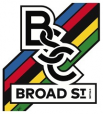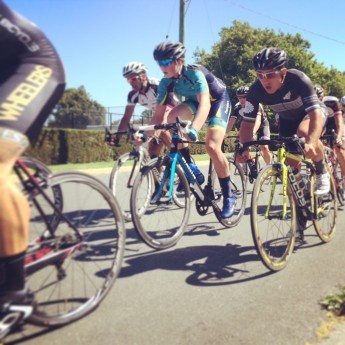Broad Street Cycles has been proud to support a number of working-class racers this road season.
Steven Grandy is a bike courier, Cat. 2 road racer, and never fails to mix it up in local and regional races. His aggressive riding and deft tactical awareness has brought him some excellent results this year, all the while riding in Broad Street Cycles/ Stuckylife kit aboard his high-viz Focus Cayo 3.0.
Race Report by Steven Grandy
The Windsor Park Criterium is a wide open flat criterium in Oak Bay put on by Oak Bay Bikes. Coincidentally, it’s the course of my first ever bike race. The turnout was good (45 riders in the “A” field.) because no other races conflicted on the calendar.
In a flat, non-selective race there is still, in fact, an order to things. The pace and accelerations order the riders based on fitness, experience and bike handling ability. Stronger riders exchange pulls and attacks at the front while those unable to spend much time in the wind, draft. Some riders with lower time-trialling ability can stay at the front based on their handling skills, while other TT powerhouses drift mid-pack due to weaker accelerations or lower handling proficiency.
I personally separate the field into thirds and try my best to stay near the front. Assuming the race finishes in a sprint, it is best to be in the front few wheels on the final corner as it may be impossible to overtake a closely matched sprinter. Vying for position anywhere farther back rarely yields much benefit.
So the questions is, why attack or go off the front if breaks are bound to fail? If you are not a dominant sprinter, then a break is a mini-field sprint. Even for non-sprinters, a break with three riders guarantees a podium position in what can be loosely considered a field sprint.
How does a break succeed? A break is more likely to succeed if the most represented teams have at least one rider in the break and they feel that their rider has an option to win. This example is most obvious in the 2014 Bastion Square Provincial Criterium Championships. Initially, there was a break with two teams represented for 20 laps (Teams H&R + Trek Red Truck.). Then, once the break was caught a new one was formed with the three dominant teams and the group lapped the field in, at most, 7 laps.
Late breaks have better chance of succeeding because of opponent fatigue and bureaucratic hindrance. Race organizers know this and give primes to keep races dynamic and interesting. Riders in big criteriums may choose to throw away their chances at winning the race because of a lucrative crowd prime. FYI, prime means bonus in French. If you don’t trust me, look at your bilingual food packaging.
So the Windsor cirterium was animated early on with a number of breakaway attempts from various riders. From the first few laps a group of 6-8 riders broke away but were chased down before they could stick it. I tried a number of times to stretch the elastic and form a fresh break, but to no avail. In the final three laps Gillian Carleton offered a lead out for a sprint. It’s remarkable but no surprise that she can maintain such a calm demeanour in the crucial final laps of crit . On the final lap at corner one, Dustin Andrews from Trek Red Truck made a late dash and managed to hold it to the line with Cid Martinez in close pursuit and Issac Leblanc a few lengths behind. For me it was a mix of chasing wheels and trying to bridge to Gillian on the final stretch. Emile DeRosnay had fresher legs and drag raced his way to 4th in front of me.
Thanks to Gillian, as I wouldn’t have felt nearly as confident moving to the front without a last minute game plan.
Follow Steven on Short & Sweet Velo and look for him at the front of regional road races all next year!


